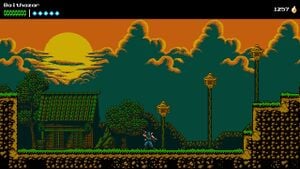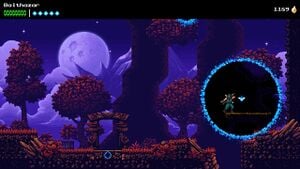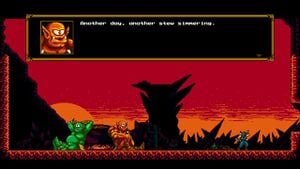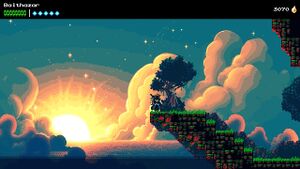The 'Shroom:Issue 165/Switch It Up!
Switch it Up!
Written by: Reverse Input| The Messenger | |
|---|---|
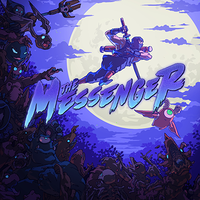
| |
| Developer | Sabotage Studio |
| Publisher | Devolver Digital |
| Platform(s) | Nintendo Switch (Other platforms: Windows, Xbox One, Playstation 4) |
| Genres | Platformer, Metroidvania |
| Rating(s) | N/A |
Hello friends, and welcome to a new(ish) section I’m putting together for you called Switch It Up! If the name seems familiar to you, that’s because I already used it before for a previous guest section where I put the spotlight on a bunch of Switch games for people to check out. To reiterate what I said there, the purpose of this section will be mainly to shine a spotlight on Nintendo Switch games which are perhaps not quite as well-known as first-party Nintendo titles and beloved indie darlings like Shovel Knight and Hades, but are still well worth looking at if you want to “switch up” your gaming habits. For this special issue, though, I’m stealing the name but changing up the format, making it into more of a traditional review section, taking a look at one particular game in a decent amount of detail instead of 10 games in very brief detail.
So, with all the formalities out of the way, let’s get into the game! In line with the Partners in Time theming going on this month, I’m here to recommend another video game that features time-travel between two eras as a major selling point. The Messenger is a side-scrolling platformer where you play as a ninja living in a remote village, who yearns to see the wider world. After his village is destroyed by the Demon King, he is saved by the “Western Hero” and tasked with bringing a mysterious scroll to the top of the nearby mountain, thereby being given the title of the Messenger. Despite bearing a retro-inspired artsyle and deriving inspiration from classics of the NES and SNES era like Ninja Gaiden, The Messenger is able to mix these older inspirations with newer concepts, making it into something unique and memorable.
Gameplay
The basic gameplay of the game is fairly simple to begin with, as the game sees you play through side-scrolling levels in typical platforming fashion, jumping on platforms and fighting a variety of enemies along the way. Alongside the typical abilities like a standard jump and a sword attack, the Messenger’s signature move is something called the Cloudstep, which allows you to get an additional jump in midair after landing a hit on something, whether it be an enemy or another hittable object in the level. This move is useful for manuverability as you go across the stage, as it lets you move around easier when you’re fighting, or even just traversing the stage. Once combined with some other moves that you pick up along the way, like shuriken, gliding and a rope dart (or, if you’d prefer, a grappling hook), you get a moveset that is still fairly straight-forward but also incredibly flexible, allowing you to travel through levels and fight bosses with a bevy of moves which can chain together and interact with each other in different ways, which makes for gameplay which is quite fluid, engaging and enjoyable. While important abilities like the ones mentioned above are gained as the story progresses, as you travel through levels, you can also pick up Time Shards which can be used to purchase upgrades from the in-game shop. These upgrades can range from more health and stamina, to new optional moves like an underwater dash or the ability to hit fireballs and other projectiles (and thereby use them for Cloudstepping as well), and even reducing the penalty for dying. Speaking of which, instead of a life system, when you die in The Messenger, you are rescued by a little demon named Quarble, who brings you back to life… for a fee. After saving you, he’ll follow you around a while and swoop up all the Time Shards you collect until he gets a certain amount back, or if a certain amount of time passes. This provides a nice way for the game to remove the good old “lives and continues” system while still having a fair penalty to make death not completely meaningless. When it comes to difficulty, the game is challenging enough that you’ll likely die a fair amount, but always balanced enough that it will feel fair. There’s nothing here that’s hard enough to be rage-inducing, and the most difficult rooms are usually only for collecting the game’s optional collectibles, so I feel it strikes a good balance for most people.
Level and World Design
With the basics of the game out of the way, let’s take a closer look at the flow of the levels through the game. To start off with, the game follows a fairly linear structure, taking you through a series of levels that are fairly straightforward “go from point A to point B” affairs, with a few extra rooms for bonus collectibles thrown in for good measure. These levels are pretty great, offering a very focused experience which gives a fair amount of challenge and good level design, resulting in levels which are really fun to work your way through. Each level also has a fairly distinct theme to it, with various locales such as forests, catacombs, a bamboo grove and, of course, the mountain. Each environment has its own unique look, enemies and boss, so they manage to differentiate themselves from each other quite well. And speaking of the bosses, all of them are pretty well-made and varied as well. Some are large creatures while others are individuals closer in size to the Messenger himself, and each individual boss has its own set of moves and hazards to deal with, meaning that every one of them feels different and unique to face off against.
(Now, at this point, you may be wondering “Where’s the time travel?” Well, keen reader, this is where we get into that. Despite it being an advertised point in the marketing of the game, the mechanic itself doesn’t show up for a while, and it also accompanies a rather major shakeup to the gameplay formula. If you’re concerned about minor spoilers that you can probably learn just from watching the trailer, then feel free to skip ahead to the next section. If not, then carry on reading!)
After a certain point in the game, you unlock a special time-travel ability of sorts, and the game shifts focus from being a linear set of stages played one after the other into a more open, Metroidvania-style exploration of the world, allowing you to go back to previous levels and enter new rooms and do new quests across the world, as well as find a few more new levels. The main paths of the level layouts remain largely unchanged, bar one exception: in several rooms, there now exist small portals that allow you to travel in time between two time periods. Graphically, this is represented by swapping between the original 8-bit graphics and a snazzy set of 16-bit graphics you get later on. In terms of gameplay, the time-period swapping will alter the terrain in various ways, such as adding or removing platforms or walls between time periods, as well as opening up new paths into rooms you couldn’t access before. While the changes may seem somewhat minor in familiar rooms, the designers still manage to make them significant enough to make the remixed versions of previous levels feel different. But where the time-travel mechanic really shines in when you get to the new areas and levels designed specifically with this mechanic in mind. These areas will have you swapping between the two much more frequently, and use the mechanic to create some neat situations where you need to swap between the two periods to open up different parts of a room to progress. These areas are the ones which really justify the time-travel mechanic, making it something that’s actually genuinely unique and worthwhile as opposed to being a minor gimmick, so they’re definitely one of the highlights of the game. When you’re not exploring new areas, however, you’ll be spending some time retreading the original levels in order to complete quests and find items to help you in your adventure. While this also makes use of the time-travel concept for some interesting ideas – for example, planting a seed in the past and collecting it as a fully-grown plant in the future – it also adds on a lot of time in backtracking, which is made worse by the fact that the levels you’re exploring, while slightly altered with the addition of the new time portals, are still quite linear, meaning you’ll likely end up going over the same sections multiple times with no differences. There are a few quick travel portals which lead to various areas, and each of the in-game shops can be used to get back to the central hub containing said portals, but this unfortunately doesn’t quite end up covering all the levels, so you should expect a bit of backtracking to be done as you play through the game. It’s not a deal breaker, of course, but still something of a negative I feel should be pointed out.
Writing and Worldbuilding
Now that we’ve talked about the gameplay and level design, there’s one more element which I feel definitely needs to have a spotlight put onto it, and that’s the game’s writing. Each character has a distinctive personality and their own little quirks which make them unique, and the dialogue throughout the game is simply top-notch. The game as a whole has a very tongue-in-cheek, meta kind of feel to it, and while this type of writing can often feel quite grating and obnoxious, the writer was able to balance things out quite well, to the point where I personally found it to be charming rather than something to groan about. During the first half of the game, the bulk of the story content occurs in discussions with the Shopkeeper, a mysterious hooded figure who seems to know a lot about the Messenger and his journey to deliver the scroll. Located in a room that can be accessed through portals spread throughout the land, the Shopkeeper is the Messenger’s main guide throughout the quest, giving him necessary advice and upgrades, as well as selling the upgrades I mentioned earlier in the review. When it comes to conversation, the Messenger and the Shopkeeper have an excellent chemistry with each other; the Messenger (or rather, the player) will often pester the shopkeeper about various things and information, and the Shopkeeper will answer in ways that are sometimes helpful or sometimes philosophical, and often pokes fun at various gaming tropes. There’s even a dedicated Chat option on the menu, where in each level you can get dialogue with the Shopkeeper about various things, including the current area you’re in and occasional tidbits about characters you met in the previous area or new items you acquired. But the best option is the “Do you have any stories to share?” option, where the Messenger asks the Shopkeeper for a story, and the Shopkeeper will reply with a short story, like a fable or similar piece of writing. Not only did I find the stories themselves genuinely interesting, but the subsequent banter between the Messenger (who usually has some complaint or confusion about the story) and the Shopkeeper is always just as entertaining, and it was this combination of factors that made me always look forward to visiting the shop every time I entered a new area.
As the game shifts focus into revisiting old areas, there is also a shift in focus in terms of characters, meaning you spend less time with the shopkeeper and a bit more time with various other characters you met throughout the game (though you still get the normal Shopkeeper conversations when you find new areas). Although the amount of dialogue is probably a bit sparser compared to the time you spend with the Shopkeeper, the other characters in the game are, as I said before, charming in their own way, and each has their own connection to the Messenger and role in the story which can lead to some interesting and fun interactions. The story itself, too, has a few little twists and turns along the way which lead to a story that, while not the most incredible or unique you’ll ever find, is still quite enjoyable and has a lot of great moments in it. It has many moments of brevity and jokes, but is also able to manage some reasonably serious moments as well, all of it typically being made better with that great dialogue writing. In fitting with the retro-style, actual “cutscenes” are probably a lot fewer than the amount of dialogue moments, but what’s there is well done and manages to round of the package’s story quite well.
Presentation and Performance
As far as the presentation is concerned, by all accounts, The Messenger both looks and runs quite well. The game uses a mix of both 8-bit and 16-bit style graphics, and each style looks quite good in its own way, while managing to look distinct from the other. In particular, while the 8-bit graphics are obviously a lot less detailed that the 16-bit, I feel that they’re still well-made enough that they’d be able to stand on their own as well-made game graphics. The transition between the two styles when you step through the time portals is quite seamless, and there’s even a few areas where you have special insects that emit a small zone which throws you into the opposite time period, making a really cool effect where you’re in 8-bit while everything else is 16-bit (or vice versa). The game’s music is also pretty great, with a different arrangement playing depending on what time period you’re in. While it’s not the most memorable soundtrack I’ve heard, each track is still different and unique, and they all fit in quite well with the stages they play in. As far as performance goes, The Messenger runs quite well in both docked and handheld modes, which shouldn’t be too big a surprise given the simpler graphical style. It maintains a steady framerate at all times, and the graphics are never fuzzy or difficult to see in any of the Switch’s modes.
Final Thoughts
As a quick side-note before I wrap up, the game also has a DLC pack called Picnic Panic, which was released a few months after the game released. It’s essentially a set of extra levels to playthrough, with their own unique story to tell using the characters from the main game, so all the things I said above will apply to that as well. It’s also available for free, so I’d definitely recommend downloading it if you buy the game itself.
Overall, I found The Messenger to be a charming, challenging and enjoyable game. While there’s some minor issues with backtracking, the excellent gameplay, level design, writing and presentation are all more than enough to make this a game worth picking up. So if you’re a fan of retro-inspired indie games and in the mood for a time-travel adventure that isn’t really anything like M&L:PiT then you should definitely give this one a look!
| The 'Shroom: Issue 165 | |
|---|---|
| Staff sections | Staff Notes • The 'Shroom Spotlight • End-of-the-Year Awards • Director Election • 'Shroomfest |
| Features | Fake News • Fun Stuff • Palette Swap • Pipe Plaza • Critic Corner • Strategy Wing |
| Specials | Switch It Up! • Killing The Killing Game |
